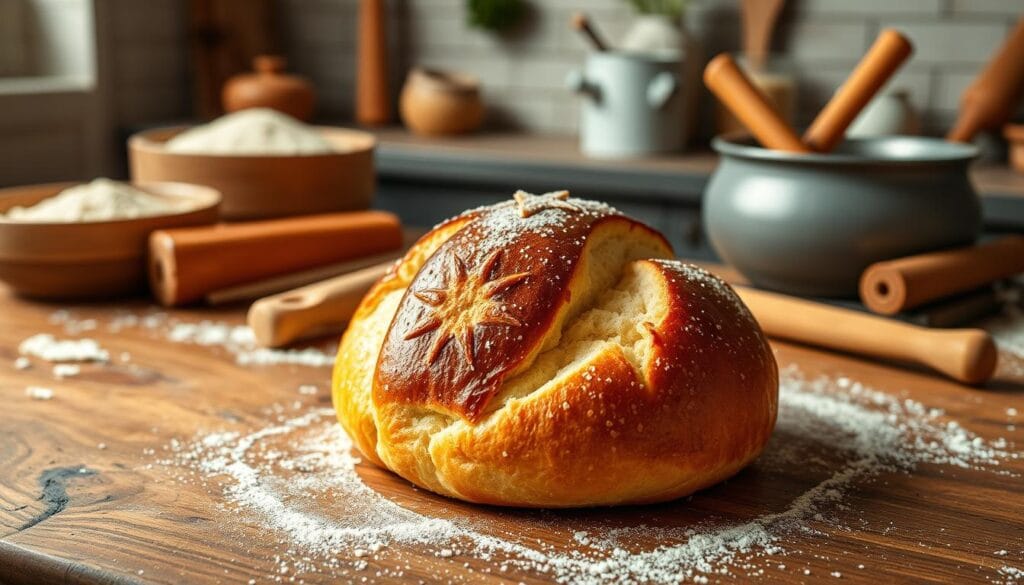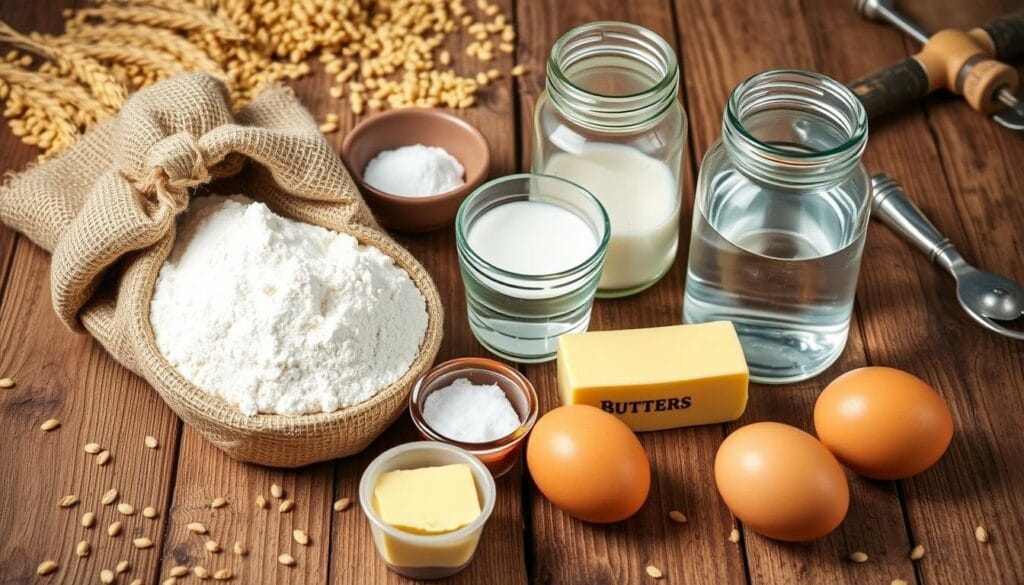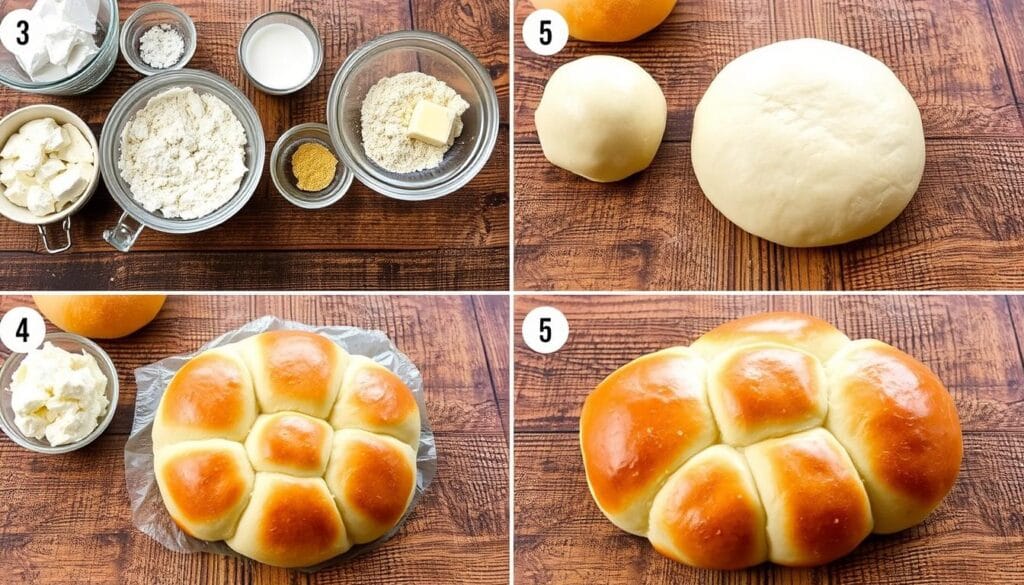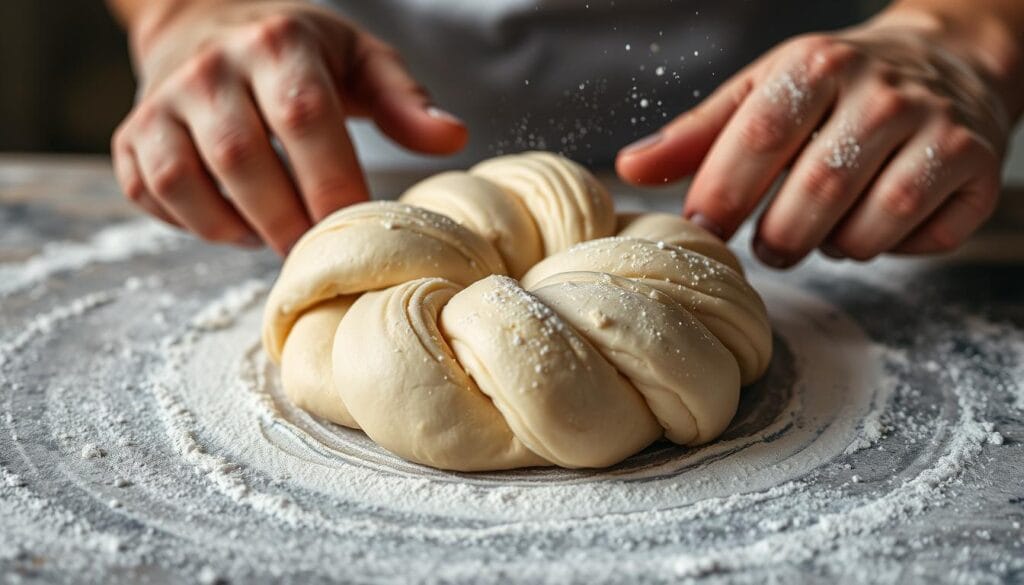Ever wondered how to make those perfect, golden-brown kaiser roll ? They turn a simple sandwich into a feast. As a home baker, I’ve worked hard to master making these Austrian breads.
Kaiser rolls have a long history, dating back to the 18th century in Vienna, Austria. They were named after Emperor Franz Joseph I. These rolls are more than just bread; they’re a piece of history you can bake at home.
Whether you’re an experienced baker or just starting, learning to make kaiser rolls is exciting. You’ll discover how to pick the best ingredients and shape them into their unique flower-like form. This guide will show you how to make authentic, delicious kaiser rolls.
Table of contents
- Understanding the History and Origins of Kaiser Rolls
- Essential Ingredients for Perfect Kaiser Rolls
- Required Equipment and Tools
- Step-by-Step Kaiser Roll Preparation
- Mastering the Kaiser Roll Shape
- Professional Dough Handling Techniques
- Creating the Perfect Crust and Texture
- Traditional Toppings and Variations
- Baking Process and Temperature Guidelines
- Storage and Serving Suggestions
- Conclusion
Understanding the History and Origins of Kaiser Rolls
The Kaiser roll has a rich history tied to Austrian bread-making. It started in Vienna in the 18th century. This bread is not just tasty; it also has a deep cultural background.

It was named after Emperor Franz Joseph I. The name “Kaiser” means “emperor” in German. This shows the bread’s royal status. Bakers made these rolls with care, adding a star-shaped top that looks like a crown.
Austrian Heritage and Cultural Significance
In Austria and Germany, the Kaiser roll is more than bread. It’s a cultural symbol. Traditional Austrian bread recipes highlight its role in everyday meals. It’s known for:
- Crusty outside and soft inside
- A five-fold star pattern
- A sweet yet savory taste
- Being used in many dishes
Evolution of Traditional Kaiser Rolls
Kaiser rolls and buns are quite different. Kaiser rolls have detailed designs and a better texture than regular buns.
| Region | Kaiser Roll Variation | Unique Characteristics |
|---|---|---|
| Austria | Traditional Kaisersemmel | Classic five-fold star pattern |
| Germany | Rye-enhanced Kaiser Roll | Incorporation of rye flour |
| United States | Topped Kaiser Roll | Sesame, poppy, or everything seasoning |
The German bread tradition has made these rolls popular. They’ve gone from a royal breakfast item to a favorite bread globally. Their flexibility keeps the Kaiser roll loved by many.
Essential Ingredients for Perfect Kaiser Rolls
Making authentic kaiser rolls begins with knowing the key ingredients. These ingredients turn simple bread flour into tasty rolls. Your baking success relies on choosing high-quality parts that work together.

- Bread flour (360g or 3 cups)
- Instant yeast (1.5 teaspoons)
- Granulated sugar (1.5 teaspoons)
- Table salt (1.25 teaspoons)
- Unsalted butter (28g or 2 tablespoons)
- Lukewarm water (170g or 3/4 cup)
When thinking about what to put on a kaiser roll, you have many tasty choices. Traditional toppings include poppy or sesame seeds. These can be sprinkled on before baking for a beautiful, textured look. Pro tip: Brush the rolls with an egg wash to help the seeds stick perfectly.
“The secret to great kaiser rolls lies in the quality of your ingredients and the care you take in preparation.”
For a special touch, consider adding malt powder or eggs. These can make the rolls taste and feel even better. The bread flour is key for a chewy roll that keeps its shape well.
Remember, precise measurements and quality ingredients are key to making great kaiser rolls. Whether for sandwiches or as a side dish, these rolls will surely wow everyone!
Required Equipment and Tools
Baking delicious bakery bread at home needs the right tools and equipment. Whether you’re new or experienced, the right kitchen tools can make a big difference. They help you make perfect round bread, like kaiser rolls.
Professional bakers say the right equipment can take your bread-making to the next level. The kaiser roll stamp is key for that star-shaped pattern on your rolls.
Essential Kitchen Tools
- Large mixing bowl
- Kitchen scale
- Measuring cups and spoons
- Dough scraper
- Baking sheet
- Parchment paper
Specialty Baking Equipment
A traditional kaiser roll stamp is the best tool for that unique textured top. These stamps come in different materials:
| Material | Pros | Cost Range |
|---|---|---|
| Wooden | Traditional feel, long-lasting | $10-$25 |
| Metal | Durable, precise imprints | $15-$35 |
| Plastic | Lightweight, affordable | $5-$15 |
Alternative Shaping Methods
Don’t worry if you don’t have a kaiser roll stamp. You can make similar patterns with:
- A sharp knife to create star-like cuts
- Cookie cutters with interesting designs
- Folding techniques that naturally create textured surfaces
“The right tool can transform an ordinary roll into a bakery-quality masterpiece.” – Professional Baker
Investing in quality equipment will help you make beautiful, professional-looking kaiser rolls. They will impress your family and friends.
Step-by-Step Kaiser Roll Preparation
Making the perfect kaiser roll recipe needs care and love. Your journey starts with knowing the key steps to make delicious bread rolls.

To begin your kaiser rolls adventure, collect these essential ingredients:
- High-protein bread flour
- Active dry yeast
- Warm water
- Salt
- Sugar
- Optional toppings like sesame or poppy seeds
First, activate the yeast. Mix warm water (around 110°F) with sugar and yeast. Wait for 5-10 minutes for it to foam. This shows your yeast is ready to work its magic.
“The secret to great kaiser rolls is patience and precise technique.” – Austrian Baking Tradition
When kneading, focus on building gluten. Knead for 8-10 minutes until the dough is smooth and elastic. It should spring back when pressed gently.
- Let the dough rise in a warm, draft-free area
- Cover with a damp cloth
- Wait until it doubles in size (approximately 1-2 hours)
Shaping your kaiser rolls needs a special technique. Use a kaiser roll stamp or make a five-point star pattern by hand-folding. This traditional method gives the rolls their crown-like look.
Pro tip for bread roll lovers: Brush the rolls with egg wash and sprinkle seeds before baking. This will give them a professional crust.
Mastering the Kaiser Roll Shape
Making the perfect kaiser roll takes skill and precision. The round bread shape is key, achieved with a special stamp or hand-shaping. Knowing what a kaiser roll is means mastering its star-like pattern.

- Select a clean, well-designed metal stamp
- Dust the stamp lightly with flour to prevent sticking
- Apply gentle, even pressure to create a crisp design
- Press the stamp directly into the center of the dough round
“The art of shaping kaiser rolls is as much about technique as it is about tradition.” – Professional Baker’s Insight
For those without a stamp, hand-knotting is a great alternative. It creates a flower-like pattern by folding the dough edges. Professional baking techniques recommend practicing hand-shaping for consistent results.
| Shaping Method | Difficulty Level | Recommended for |
|---|---|---|
| Kaiser Roll Stamp | Beginner | Quick and consistent results |
| Hand-Knotting | Intermediate | Traditional artisan approach |
Pro tip: Keep dough hydration consistent and let it rest well. This helps your kaiser rolls keep their shape during proofing and baking.
Professional Dough Handling Techniques
Making the perfect bread roll is more than just mixing ingredients. It takes precision and skill. Professional bakers know that handling dough right is key to making tasty kaiser rolls.
To understand why kaiser rolls are so loved, you must learn how to handle the dough. Let’s explore the professional methods that can improve your bread-making skills.
Temperature Control Mastery
Temperature is very important in making bread rolls. Here are some temperature tips:
- Yeast needs water between 105°F and 115°F to activate
- Warm ingredients help yeast grow
- Keep the room temperature steady during proofing
Precision Kneading Methods
Kneading turns raw ingredients into smooth, elastic dough. Here are some professional tips:
- Mix on low speed for 4 minutes
- Switch to medium speed when adding salt and butter
- Knead for 8-10 minutes until dough is stretchy
Achieving Perfect Dough Consistency
The secret to amazing kaiser rolls is in the dough’s consistency. Here are some tips:
- Use a mix of all-purpose and bread flour for the right protein
- Go for a hydration level that makes the dough soft
- Do the poke test to see if the dough is ready
“Great bread is a result of patience, precision, and passion.” – Professional Baker’s Wisdom
By mastering these dough handling techniques, you’ll make kaiser rolls that will wow bread lovers.
Creating the Perfect Crust and Texture
Making a crusty roll with the right texture is all about precision and knowing your baking science. Kaiser rolls are a top example of bread making, with a crispy outside and a soft inside. The secret to their greatness is finding the perfect balance between the crust and the crumb.
To make a high-quality hard roll, focus on a few important techniques:
- Use high-protein bread flour for maximum structure
- Create steam during the initial baking phase
- Maintain precise oven temperatures
- Develop proper dough hydration
“The perfect kaiser roll is a symphony of crisp exterior and tender interior.” – Artisan Baker’s Creed
Steam is key for that golden-brown crust. Bakers suggest pouring one cup of water onto a hot baking sheet early in baking. This method helps get that crispy outside while keeping the inside soft and airy.
| Baking Parameter | Recommended Setting |
|---|---|
| Oven Temperature | 450°F |
| Baking Time | 17-21 minutes |
| Steam Application | First 5 minutes |
Temperature control and timing are essential for transforming simple ingredients into a perfect kaiser roll. By mastering these techniques, you’ll improve your baking and make rolls that are crispy outside, soft inside, and super tasty.
Traditional Toppings and Variations
Kaiser rolls are super versatile. They can be turned into amazing sandwiches and burgers. The right toppings make a big difference.
Classic Seed Options
For a classic kaiser roll, try these seed toppings:
- Poppy seeds
- Sesame seeds
- Coarse salt
- Caraway seeds
Alternative Toppings for Kaiser Roll Burgers
Make your kaiser roll burger stand out with these toppings:
- Fresh herbs like rosemary or thyme
- Grated parmesan cheese
- Caramelized onions
- Roasted garlic
Regional Variations and Serving Suggestions
Each region has its own way of enjoying kaiser rolls. Try different BBQ sauces to find your favorite flavor.
| Region | Unique Topping | Flavor Profile |
|---|---|---|
| Midwest | Everything Bagel Seasoning | Savory, Complex |
| Southwest | Chili Powder | Spicy, Bold |
| Northeast | Dried Herbs | Aromatic, Delicate |
“A great kaiser roll is like a blank canvas – waiting for your culinary creativity!” – Chef Mark Rodriguez
Try different toppings to find your favorite kaiser roll sandwich!
Baking Process and Temperature Guidelines
Making perfect bakery bread needs precision, like with kaiser rolls. Bakers know that temperature and technique are key. They aim for hard rolls with a golden, crisp outside.
The best way to bake kaiser rolls involves several steps:
- Preheat your oven to 450°F for the best results
- Put rolls on a baking sheet with parchment paper
- Make steam in the oven with a water pan on the bottom rack
- Turn the pan halfway for even browning
When baking kaiser rolls, follow these important timing tips:
- Bake for 20-25 minutes
- Check the internal temperature is at least 190°F
- Look for a deep golden-brown crust
“The secret to a perfect kaiser roll is in the baking temperature and technique.” – Professional Baker’s Wisdom
Pro tip: Use a digital thermometer to ensure your rolls are perfectly baked every time.
For home bakers, knowing these temperature and baking tips can make your crusty rolls amazing.
Storage and Serving Suggestions
Keeping your homemade kaiser rolls fresh is important. Here’s how to keep your ingredients fresh. At room temperature, kaiser rolls stay good for 2-3 days in a sealed bag or container.
- Refrigerate kaiser rolls for up to one week
- Freeze rolls for extended preservation
- Wrap individually in plastic wrap before freezing
When making a kaiser roll burger, freshness matters a lot. If you’re looking for kaiser rolls, check local bakeries and specialty stores. They usually have these tasty breads. Look for rolls with a crisp outside and soft inside.
“A great sandwich starts with great bread” – Artisan Baker’s Wisdom
Here are some tips for reheating kaiser rolls:
- Thaw frozen rolls at room temperature
- Warm briefly in a 350°F oven for 3-5 minutes
- Restore crispness by lightly toasting
Pro tip: For the best kaiser roll sandwich, eat within 48 hours of baking or buying.
FAQ
What exactly is a kaiser roll?
How is a kaiser roll different from a regular hamburger bun?
What are the traditional toppings for kaiser rolls?
Can I make kaiser rolls at home without a special stamp?
What are the best uses for kaiser rolls?
How long do kaiser rolls stay fresh?
Are kaiser rolls nutritionally different from other bread rolls?
What equipment do I need to make authentic kaiser rolls?
Can kaiser rolls be made with gluten-free flour?
What is the origin of the kaiser roll’s name?
Conclusion
Learning about kaiser rolls is more than just a bread recipe. It’s a dive into Austrian bread traditions. You’ve now connected with generations of German bread makers.
Kaiser rolls are versatile and key in your cooking. They’re perfect for gourmet sandwiches or European breakfasts. Your newfound skills will make your kitchen creations stand out.
Bread-making is both art and science. Every kaiser roll you make shares a story of patience and passion. Keep experimenting and sharing your bread with others. The world of artisan bread is full of delicious adventures.
Embrace the tradition of kaiser rolls and grow your baking skills. With practice, you’ll make perfect rolls that honor their roots.

